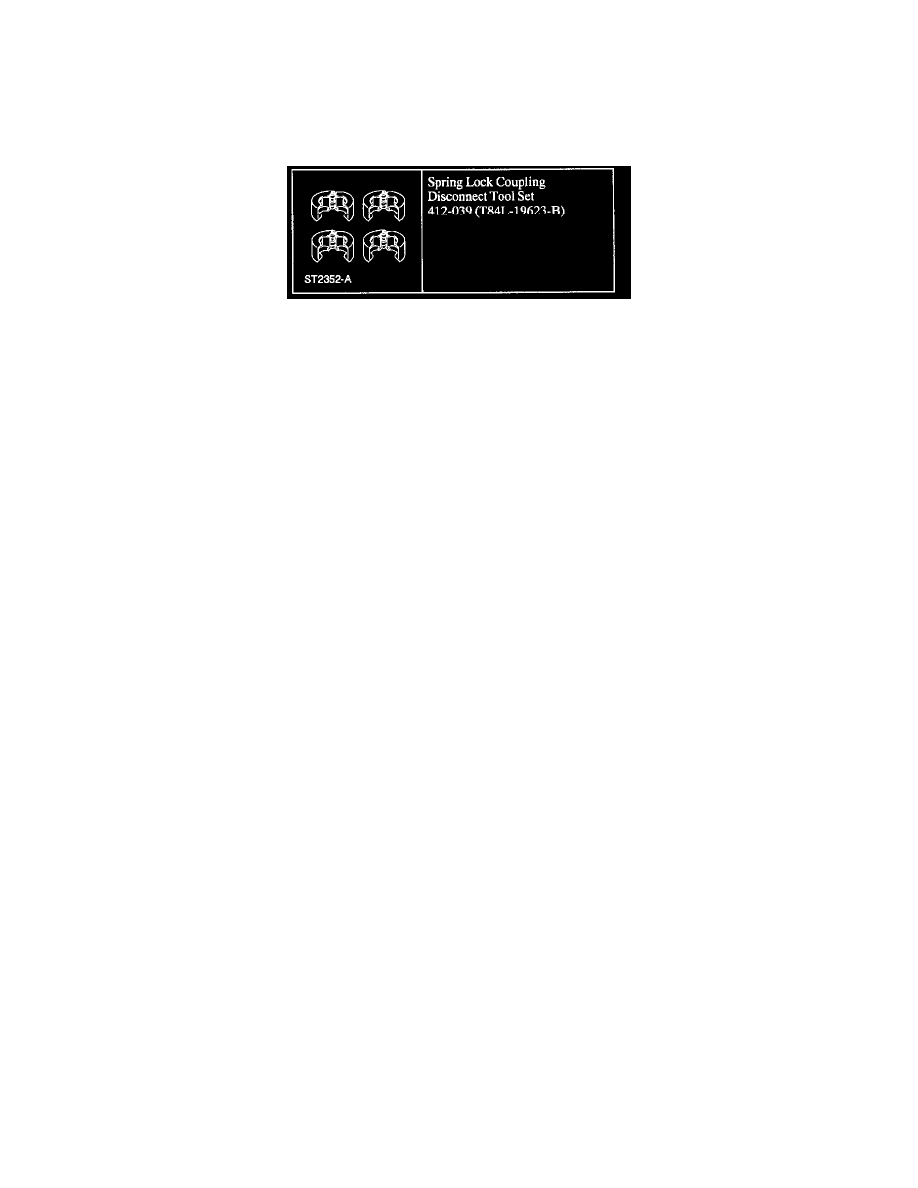F 350 4WD Pickup V8-351 5.8L VIN H EFI (1997)

Evaporator Core: Service and Repair
Removal and Installation
NOTE: Before replacing any A/C evaporator core within the warranty for suspected refrigerant leaks, it is mandatory that an on-vehicle leak test be
performed.
SPECIAL SERVICE TOOL(S) REQUIRED
Spring Lock Coupling
Description
Tool Number
Spring Lock coupling Disconnect Tool Set
T84L-19623-B
REMOVAL
1. Recover refrigerant system following recommended service procedures. Observe all safety precautions. See: Service and Repair/Refrigerant
Recovery
NOTE: Cap all open refrigerant lines and components to prevent entry of dirt and moisture into the A/C system.
2. Disconnect electrical connector from A/C cycling switch on side of suction accumulator/drier.
3. Remove A/C cycling switch from suction accumulator/drier.
4. Disconnect A/C manifold and tube from suction accumulator/drier. Use a backup wrench to loosen fitting. Cap evaporator to compressor suction
line and suction accumulator/drier to prevent entry of dirt and excess moisture.
5. Using Spring Lock Coupling Disconnect Tool Set T84L-19623-B, disconnect condenser to evaporator tube from A/C evaporator core. Cap
condenser to evaporator tube to prevent entry of dirt and excess moisture.
6. In passenger compartment, remove one screw retaining A/C evaporator housing.
7. Remove one nut retaining MAP sensor bracket, (if equipped), to the upper left corner of A/C evaporator case.
8. Remove spring clip holding MAP sensor, (if equipped), to housing. Put MAP sensor, (if equipped), aside.
9. Remove one nut retaining upper left corner of A/C evaporator case to dash panel.
10. Remove six screws retaining left A/C evaporator case cover to A/C evaporator case.
11. Remove left A/C evaporator case cover from A/C evaporator case.
12. Remove two screws retaining suction accumulator/drier to A/C evaporator housing.
13. Remove A/C evaporator core and suction accumulator/drier from A/C evaporator case.
INSTALLATION
1. Install A/C evaporator core into A/C evaporator case.
2. Position A/C evaporator case cover to A/C evaporator case. Install six screws to retain A/C evaporator case cover to A/C evaporator case along
flange.
3. Install one nut to retain upper left corner of A/C evaporator case to dash panel.
4. Install one spring clip to rib on A/C evaporator case and push into position.
5. Install one nut to retain upper left corner of MAP sensor bracket, (if equipped), to the upper left corner of A/C evaporator case.
6. In passenger compartment, install one screw to retain lower edge of the heater air plenum chamber and bottom of the A/C evaporator case to dash
panel.
7. Remove cap from condenser to evaporator tube connection and install a new A/C evaporator core orifice in the tube.
8. Using new O-ring lubricated with clean refrigerant oil, connect condenser to evaporator tube to A/C evaporator core. Push spring lock coupling
until it snaps secure. Pull back to make sure connection is completed.
9. Add 88.7 ml (3 ounces) of clean refrigerant oil to a new suction accumulator/drier to compensate for oil lost in replacement of A/C evaporator
core.
10. Using a new O-ring lubricated with clean refrigerant oil, connect suction accumulator/drier to A/C evaporator core.
11. Install A/C accumulator bracket (two screws). Tighten fitting to 21-27 Nm (15-20 lb-ft). Use a backup wrench on suction accumulator/drier to
prevent component damage.
12. Connect suction accumulator/drier to the A/C evaporator housing with two screws.
13. Using a new O-ring lubricated with clean refrigerant oil, connect A/C manifold and tube to suction accumulator/drier. Use a backup wrench to
prevent component damage.
14. Using a new O-ring lubricated with clean refrigerant oil, install A/C cycling switch on suction accumulator/drier nipple.
15. Connect electrical connector to A/C cycling switch.
16. Leak test, recover, evacuate, and charge system following recommended procedures. Observe all safety precautions. See: Service and Repair
